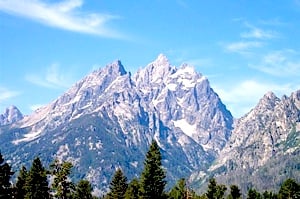Say what you will about corporate altruism, whether it's self-serving or truly benevolent, but in the case of Grand Teton, without it the park would be a shell of its present form.

Grand Teton National Park 1929 dedication ceremony with Horace Albright pictured / NPS file
When President Calvin Coolidge created the park in 1929, the legislation called for preservation of just 96,000 acres (38,850 hectares), acres that encompassed little more than the jagged roof of the Teton Range and the six glacial lakes that sprawl at the bottom of the mountains' eastern flanks.
No doubt, this 96,000-acre (38,850-hectare) preserve was stunning, and the initial legislation would see that it would indeed be protected for the enjoyment of future generations. But without the intervention of John D. Rockefeller, Jr., working through his Snake River Land Company to buy up thousands of acres that extended beyond that initial allotment, it's very possible, and highly likely, that the view we have today of the park would be filled with a foreground of development, not rolling sagebrush fields, timbered plateaus, and the uncluttered and beautifully meandering braids of the Snake River.
While you can envision this scenario from U.S. 89/191 as you head north and south through the park, perhaps the best view to be had of Grand Teton National Park is from its roof -- standing atop the 13,770-foot-tall (4,197 m) Grand Teton itself.

The Tetons, Grand Teton National Park
Kurt Repanshek photo
The Grand Teton is the biggest "Stop Sign" in the West, no matter from which direction you spy it. Alongside the Middle Teton and South Teton, the Grand scrapes the sky with its distinctive "horn," a reminder that glaciers helped mold this landscape. With a dozen or so neighboring summits that rise above 10,000 feet (3,048 m), the Tetons form a ponderous, jagged stretch of rock that arguably is the Lower 48's most arresting mountain range.
Although the Tetons are one of the youngest ranges in the Rocky Mountains, their geology is one of the most varied among the world's mountainous regions. Vast inland seas, periodic volcanics, deep glaciations and geologic machinations all played a role in defining the landscape that today retains those events in fossilized plant and dinosaur remains, thick sedimentary rocks, stunning peaks and U-shaped canyons.
It was a vast glaciation that arrived 150,000 years ago with rivers of ice 3,000 feet (914 m) thick that sculpted the mountains with cirques and cols and created the Tetons' defining pyramid-shaped peaks.
As the glaciers retreated, they left behind morainal lakes and kettles -- depressions created when blocks of ice calved from the retreating glaciers and, when they melted, created ponds in the depressions formed by their weight. Skillet, Teton and Schoolroom glaciers remain today, vestiges of their "Little Ice Age" forefathers of 5,000 years ago.
Geology aside, the abruptness with which the Tetons climb out of the valley, their easy access, and the countless climbing opportunities, combine to define the range as one of mountaineering's classics.
As I indicated above, the view from the top of the Grand is spectacular, the best to be had in the park, and it's from this vantage point that one can truly appreciate the behind-the-scenes efforts Mr. Rockefeller made to protect this setting. Far below to the east the Jackson Hole Valley stretches north and south, while Idaho lies to the west.
You can easily see the shimmering waters of Jackson and Jenny lakes far below, as well as "Timbered Island," a sliver of forest southeast of Jenny Lake that sprouted atop a glacial moraine and is popular with elk.
Now, while Mr. Rockefeller was highly instrumental in the creation of today's Grand Teton National Park, he didn't single-handedly get the deed one. His land company did amass roughly 35,000 acres (14,164 hectares) in the valley that lies below the Tetons.
But it took his pestering, and threats of selling the land for development, that led President Franklin Delano Roosevelt to create the 221,000-acre (89,436-hectare) Jackson Hole National Monument. This March 15, 1943 proclamation combined Mr. Rockefeller's acreage with Jackson Lake, Teton National Forest lands and other federal properties.
While politics clouded the park's future for seven years, on September 14, 1950, President Harry S Truman signed a bill that merged the original 1929 park with the 1943 monument to create today's masterpiece.
Controversial? Heck yeah.
But in hindsight, who could argue with the foresight of Mr. Rockefeller and Presidents Roosevelt and Truman? Grand Teton is much more than a park of incredible mountains. The lakes, like jewels on a necklace, are perfect for picnics, paddling, and, if it's hot enough, a dip. The Snake River is a joy both to raft or kayak and to hike along to spot wildlife such as bald eagles, osprey, moose and bison, or simply to while the hours away with a fishing pole.
Indeed, this park is as grand as its name implies.





